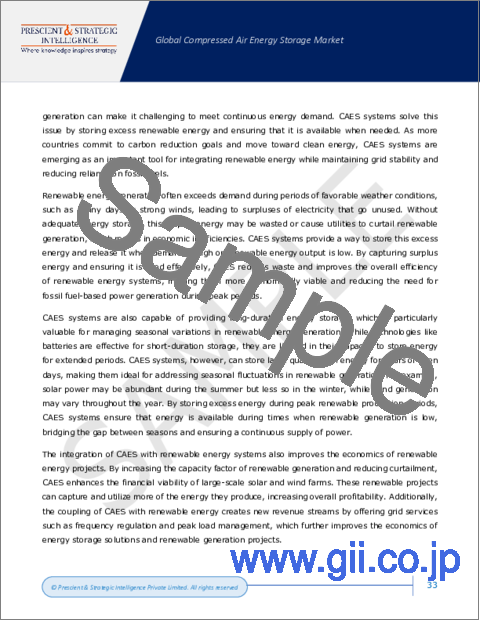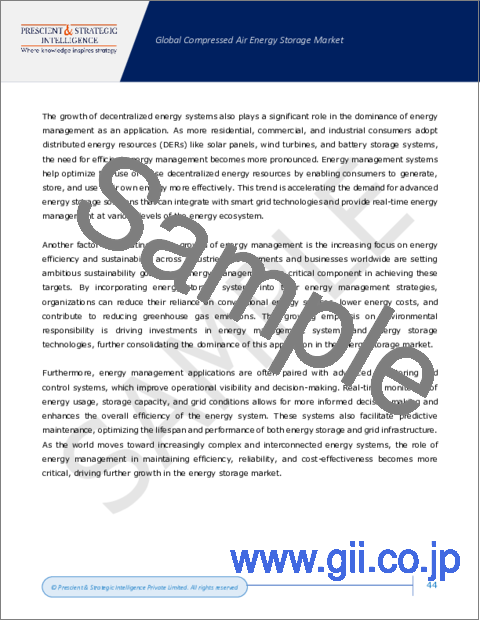|
|
市場調査レポート
商品コード
1424965
圧縮空気エネルギー貯蔵 (CAES) の世界市場:市場規模・シェア分析 (種類別・貯蔵方法別・用途別)、産業需要の予測 (2030年まで)Compressed Air Energy Storage Market Size and Share Analysis by Type, Storage, Application - Global Industry Demand Forecast to 2030 |
||||||
|
|||||||
| 圧縮空気エネルギー貯蔵 (CAES) の世界市場:市場規模・シェア分析 (種類別・貯蔵方法別・用途別)、産業需要の予測 (2030年まで) |
|
出版日: 2024年02月01日
発行: Prescient & Strategic Intelligence
ページ情報: 英文 250 Pages
納期: 2~3営業日
|
全表示
- 概要
- 目次
圧縮空気エネルギー貯蔵 (CAES) 市場は、2024~2030年に23.7%のCAGRで成長し、2030年には266億530万米ドルに達すると予測されます。これは、世界人口の増加に伴う電力需要の全体的な急増によるものです。同時に、石炭ベース発電の代替手段へのニーズが高まっていることも、市場の主な促進要因となっています。
CAESとは、エネルギーを一度貯蔵して後で利用するものです。さらに、断熱式CAESはこの技術の高度なバリエーションであり、断熱状態 (圧縮・膨張プロセス中に環境への熱伝達がないこと) を維持することに重点を置いています。その結果、エネルギー損失が最小限に抑えられ、効率が向上します。また、電力需要の変化に迅速に対応できるため、系統安定性という利点もあり、ピーク負荷の管理にも役立ちます。
従来型CAES貯蔵の市場シェアが拡大:
予測期間中、従来型CAESのシェアが大きくなると予想されます。その理由として、従来型技術の方がコスト効率と信頼性に優れていることが挙げられます。この方法では、圧縮空気を貯蔵するために大規模な地下層を使用します。さらに、この方法は運用効率が高いという特徴があり、世界中で広く利用されています。
同様に、液体ガスもCAESの革新的なアプローチであるため、この10年間に堅調なCAGRで成長すると思われます。液体ガスは、低温の液体空気や液体窒素にエネルギーを貯蔵するため、従来のアプローチとは異なります。貯蔵されたエネルギーは、電気が必要なときにガスに変換されます。基本的にエネルギー変換効率が高く、環境への影響は圧縮に利用するエネルギー源と使用する極低温液体の種類に依存します。したがって、クリーンなエネルギー源を動力源とする場合、液体ガス式CAESはさらに大きな環境上の利点をもたらす可能性があります。
エネルギー管理用途が市場を独占:
エネルギー管理は、圧縮空気エネルギー貯蔵市場において、用途別で圧倒的シェアを占めるカテゴリーです。これは、CAESが化石燃料ベースのエネルギー源への依存を減らすため、発電所への活用に大きな可能性を持っているためです。そのため、周波数制御、電圧調整、負荷シフト、ピーク負荷管理などの複数の機能を大規模発電所で利用することができます。
当レポートでは、世界の圧縮空気エネルギー貯蔵 (CAES) の市場について分析し、市場の基本構造・最新情勢や主な促進・抑制要因、世界全体および地域別・主要国の市場規模の動向見通し (金額ベース、2017~2030年)、種類別・貯蔵方法別・用途別の詳細動向、現在の市場競争の状況、主要企業のプロファイルなどを調査しております。
目次
第1章 調査範囲
第2章 調査手法
第3章 エグゼクティブサマリー
第4章 市場指標
第5章 業界の展望
- 市場力学
- 動向
- 促進要因
- 抑制要因/課題
- 促進要因/抑制要因の影響分析
- 新型コロナウイルス感染症 (COVID-19) の影響
- ポーターのファイブフォース分析
第6章 世界市場
- 概要
- 市場収益:種類別 (2017~2030年)
- 市場収益:貯蔵方法別 (2017~2030年)
- 市場収益:用途別 (2017~2030年)
- 市場収益:地域別 (2017~2030年)
第7章 北米市場
- 概要
- 市場収益:種類別 (2017~2030年)
- 市場収益:貯蔵方法別 (2017~2030年)
- 市場収益:用途別 (2017~2030年)
- 市場収益:国別 (2017~2030年)
第8章 欧州市場
第9章 アジア太平洋市場
第10章 ラテンアメリカ市場
第11章 中東・アフリカ (MEA) 市場
第12章 米国市場
- 概要
- 市場収益:種類別 (2017~2030年)
- 市場収益:貯蔵方法別 (2017~2030年)
- 市場収益:用途別 (2017~2030年)
第13章 カナダ市場
第14章 ドイツ市場
第15章 フランス市場
第16章 英国市場
第17章 イタリア市場
第18章 スペイン市場
第19章 日本市場
第20章 中国市場
第21章 インド市場
第22章 オーストラリア市場
第23章 韓国市場
第24章 ブラジル市場
第25章 メキシコ市場
第26章 サウジアラビア市場
第27章 南アフリカ市場
第28章 アラブ首長国連邦 (UAE) 市場
第29章 競合情勢
- 市場参入企業とその提供製品/サービスの一覧
- 主要企業の競合ベンチマーク
- 主要企業の製品ベンチマーク
- 最近の戦略展開状況
第30章 企業プロファイル
- Siemens AG
- Hydrostor Inc.
- Pacific Gas and Electric Company
- Apex Compressed Air Energy Storage LLC
第31章 付録
The compressed air energy storage market is projected to grow at a CAGR of 23.7% during 2024-2030, to reach USD 26,605.3 million by 2030. This will be due to the increase in the global population, accompanied by a surge in the overall power demand. Along with this, the escalating need for alternatives to coal-based energy generation is a major driver for the market.
Compressed air energy storage (CAES) permits energy to be stored once and utilized later. Moreover, adiabatic CAES is an advanced variation of this technology as it focuses on maintaining adiabatic conditions, which are characterized by no heat transfer to the environment during the compression and expansion process. This results in the minimization of energy loss and increase in efficiency. It also offers the advantage of grid stability as it can swiftly respond to the changes in electricity demand, hence helping manage peak loads.
Traditional CAES Storage To Have Larger Market Share
The traditional category is expected to have the larger share during the forecast period, based on storage. This is because the conventional technology is cost-effective and reliable. This method involves the use of large underground geological formations to store compressed air. Moreover, the approach is characterized by its high operational efficiency, due to which it is widely used around the world.
Likewise, the liquid gas category will witness a robust CAGR over this decade, as it is an innovative approach to CAES. It is different from the traditional approach as it stores energy in liquid air or liquid nitrogen at low temperatures. The stored energy is further converted to a gas when electricity is required. Essentially, it has a high energy conversion efficiency, and its environmental impact depends on the energy source utilized for compression and the type of cryogenic liquid used. Thus, when powered by clean energy sources, liquid-gas CAES has the potential to deliver even more-significant environmental advantages.
Energy Management Application Dominates Market
Energy management is the dominating category in the compressed air energy storage market, under segmentation by application. This is because CAES holds a significant potential for application in power plants as it reduces the dependence on fossil-fuel-based
energy sources. Thus, it could be utilized in large power plants for multiple functions, such as frequency control, voltage regulation, load shifting, and peak load management.
Some of the key players in the global compressed air energy storage market are Siemens AG, Hydrostor Inc., Pacific Gas and Electric Company, and Apex Compressed Air Energy Storage LLC.
Table of Contents
Chapter 1. Research Scope
- 1.1. Research Objectives
- 1.2. Market Definition
- 1.3. Analysis Period
- 1.4. Market Size Breakdown by Segments
- 1.4.1. Market size breakdown, by type
- 1.4.2. Market size breakdown, by storage
- 1.4.3. Market size breakdown, by application
- 1.4.4. Market size breakdown, by region
- 1.4.5. Market size breakdown, by country
- 1.5. Market Data Reporting Unit
- 1.5.1. Value
- 1.6. Key Stakeholders
Chapter 2. Research Methodology
- 2.1. Secondary Research
- 2.1.1. Paid
- 2.1.2. Unpaid
- 2.1.3. P&S Intelligence database
- 2.2. Primary Research
- 2.3. Market Size Estimation
- 2.4. Data Triangulation
- 2.5. Currency Conversion Rates
- 2.6. Assumptions for the Study
- 2.7. Notes and Caveats
Chapter 3. Executive Summary
Chapter 4. Market Indicators
Chapter 5. Industry Outlook
- 5.1. Market Dynamics
- 5.1.1. Trends
- 5.1.2. Drivers
- 5.1.3. Restraints/challenges
- 5.1.4. Impact analysis of drivers/restraints
- 5.2. Impact of COVID-19
- 5.3. Porter's Five Forces Analysis
- 5.3.1. Bargaining power of buyers
- 5.3.2. Bargaining power of suppliers
- 5.3.3. Threat of new entrants
- 5.3.4. Intensity of rivalry
- 5.3.5. Threat of substitutes
Chapter 6. Global Market
- 6.1. Overview
- 6.2. Market Revenue, by Type (2017-2030)
- 6.3. Market Revenue, by Storage (2017-2030)
- 6.4. Market Revenue, by Application (2017-2030)
- 6.5. Market Revenue, by Region (2017-2030)
Chapter 7. North America Market
- 7.1. Overview
- 7.2. Market Revenue, by Type (2017-2030)
- 7.3. Market Revenue, by Storage (2017-2030)
- 7.4. Market Revenue, by Application (2017-2030)
- 7.5. Market Revenue, by Country (2017-2030)
Chapter 8. Europe Market
- 8.1. Overview
- 8.2. Market Revenue, by Type (2017-2030)
- 8.3. Market Revenue, by Storage (2017-2030)
- 8.4. Market Revenue, by Application (2017-2030)
- 8.5. Market Revenue, by Country (2017-2030)
Chapter 9. APAC Market
- 9.1. Overview
- 9.2. Market Revenue, by Type (2017-2030)
- 9.3. Market Revenue, by Storage (2017-2030)
- 9.4. Market Revenue, by Application (2017-2030)
- 9.5. Market Revenue, by Country (2017-2030)
Chapter 10. LATAM Market
- 10.1. Overview
- 10.2. Market Revenue, by Type (2017-2030)
- 10.3. Market Revenue, by Storage (2017-2030)
- 10.4. Market Revenue, by Application (2017-2030)
- 10.5. Market Revenue, by Country (2017-2030)
Chapter 11. MEA Market
- 11.1. Overview
- 11.2. Market Revenue, by Type (2017-2030)
- 11.3. Market Revenue, by Storage (2017-2030)
- 11.4. Market Revenue, by Application (2017-2030)
- 11.5. Market Revenue, by Country (2017-2030)
Chapter 12. U.S. Market
- 12.1. Overview
- 12.2. Market Revenue, by Type (2017-2030)
- 12.3. Market Revenue, by Storage (2017-2030)
- 12.4. Market Revenue, by Application (2017-2030)
Chapter 13. Canada Market
- 13.1. Overview
- 13.2. Market Revenue, by Type (2017-2030)
- 13.3. Market Revenue, by Storage (2017-2030)
- 13.4. Market Revenue, by Application (2017-2030)
Chapter 14. Germany Market
- 14.1. Overview
- 14.2. Market Revenue, by Type (2017-2030)
- 14.3. Market Revenue, by Storage (2017-2030)
- 14.4. Market Revenue, by Application (2017-2030)
Chapter 15. France Market
- 15.1. Overview
- 15.2. Market Revenue, by Type (2017-2030)
- 15.3. Market Revenue, by Storage (2017-2030)
- 15.4. Market Revenue, by Application (2017-2030)
Chapter 16. U.K. Market
- 16.1. Overview
- 16.2. Market Revenue, by Type (2017-2030)
- 16.3. Market Revenue, by Storage (2017-2030)
- 16.4. Market Revenue, by Application (2017-2030)
Chapter 17. Italy Market
- 17.1. Overview
- 17.2. Market Revenue, by Type (2017-2030)
- 17.3. Market Revenue, by Storage (2017-2030)
- 17.4. Market Revenue, by Application (2017-2030)
Chapter 18. Spain Market
- 18.1. Overview
- 18.2. Market Revenue, by Type (2017-2030)
- 18.3. Market Revenue, by Storage (2017-2030)
- 18.4. Market Revenue, by Application (2017-2030)
Chapter 19. Japan Market
- 19.1. Overview
- 19.2. Market Revenue, by Type (2017-2030)
- 19.3. Market Revenue, by Storage (2017-2030)
- 19.4. Market Revenue, by Application (2017-2030)
Chapter 20. China Market
- 20.1. Overview
- 20.2. Market Revenue, by Type (2017-2030)
- 20.3. Market Revenue, by Storage (2017-2030)
- 20.4. Market Revenue, by Application (2017-2030)
Chapter 21. India Market
- 21.1. Overview
- 21.2. Market Revenue, by Type (2017-2030)
- 21.3. Market Revenue, by Storage (2017-2030)
- 21.4. Market Revenue, by Application (2017-2030)
Chapter 22. Australia Market
- 22.1. Overview
- 22.2. Market Revenue, by Type (2017-2030)
- 22.3. Market Revenue, by Storage (2017-2030)
- 22.4. Market Revenue, by Application (2017-2030)
Chapter 23. South Korea Market
- 23.1. Overview
- 23.2. Market Revenue, by Type (2017-2030)
- 23.3. Market Revenue, by Storage (2017-2030)
- 23.4. Market Revenue, by Application (2017-2030)
Chapter 24. Brazil Market
- 24.1. Overview
- 24.2. Market Revenue, by Type (2017-2030)
- 24.3. Market Revenue, by Storage (2017-2030)
- 24.4. Market Revenue, by Application (2017-2030)
Chapter 25. Mexico Market
- 25.1. Overview
- 25.2. Market Revenue, by Type (2017-2030)
- 25.3. Market Revenue, by Storage (2017-2030)
- 25.4. Market Revenue, by Application (2017-2030)
Chapter 26. Saudi Arabia Market
- 26.1. Overview
- 26.2. Market Revenue, by Type (2017-2030)
- 26.3. Market Revenue, by Storage (2017-2030)
- 26.4. Market Revenue, by Application (2017-2030)
Chapter 27. South Africa Market
- 27.1. Overview
- 27.2. Market Revenue, by Type (2017-2030)
- 27.3. Market Revenue, by Storage (2017-2030)
- 27.4. Market Revenue, by Application (2017-2030)
Chapter 28. U.A.E. Market
- 28.1. Overview
- 28.2. Market Revenue, by Type (2017-2030)
- 28.3. Market Revenue, by Storage (2017-2030)
- 28.4. Market Revenue, by Application (2017-2030)
Chapter 29. Competitive Landscape
- 29.1. List of Market Players and their Offerings
- 29.2. Competitive Benchmarking of Key Players
- 29.3. Product Benchmarking of Key Players
- 29.4. Recent Strategic Developments
Chapter 30. Company Profiles
- 30.1. Siemens AG
- 30.1.1. Business overview
- 30.1.2. Product and service offerings
- 30.1.3. Key financial summary
- 30.2. Hydrostor Inc.
- 30.2.1. Business overview
- 30.2.2. Product and service offerings
- 30.2.3. Key financial summary
- 30.3. Pacific Gas and Electric Company
- 30.3.1. Business overview
- 30.3.2. Product and service offerings
- 30.3.3. Key financial summary
- 30.4. Apex Compressed Air Energy Storage LLC
- 30.4.1. Business overview
- 30.4.2. Product and service offerings
- 30.4.3. Key financial summary
Chapter 31. Appendix
- 31.1. Abbreviations
- 31.2. Sources and References
- 31.3. Related Reports






